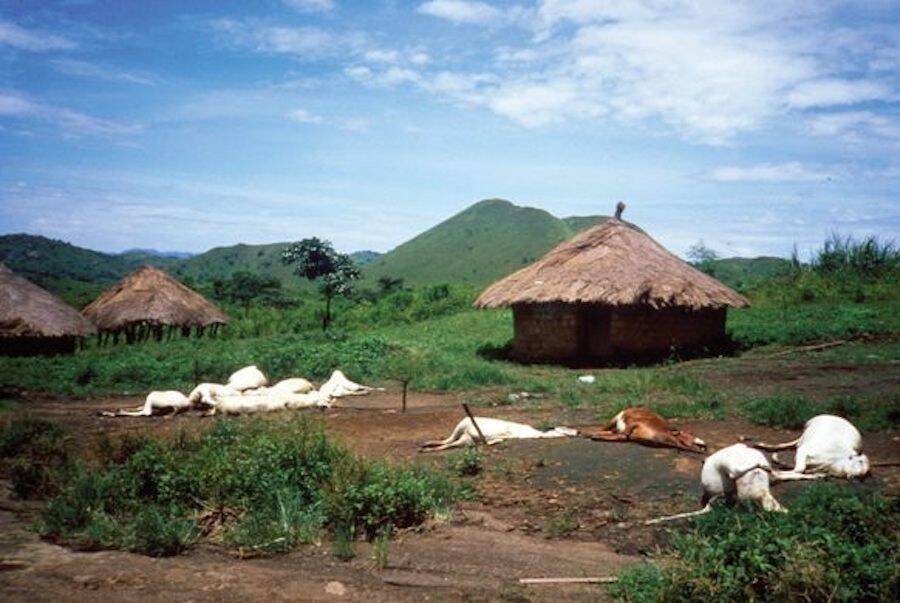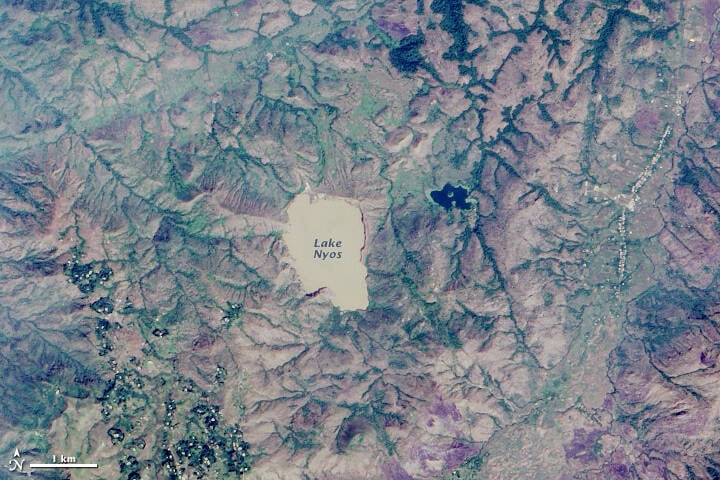A massive cloud of carbon dioxide emerged from Cameroon's Lake Nyos on August 21, 1986, ending the lives of more than 1,700 people and 3,500 animals.

U.S. Geological SurveyDead cattle, pictured after the Lake Nyos disaster of 1986.
On August 21, 1986, a catastrophic event now known as the Lake Nyos disaster unfolded at Lake Nyos in Cameroon. A mix of carbon dioxide and water droplets, previously trapped in the lake’s depths, suddenly burst forth and erupted to the surface. This rare phenomenon, known as a limnic eruption, created a deadly, invisible gas cloud that engulfed nearby villages.
This unseen killer suffocated over 1,700 people and more than 3,500 livestock, displacing thousands more locals as they fled the area.
So what happened? Scientists believe the root cause of this tragedy lies in the region’s history of volcanic activity. Over the years, CO2 had gradually leaked into the lake, creating an explosive time bomb. A disturbance, possibly a landslide, earthquake, or simply too much gas built up, acted as a trigger, setting off the catastrophic release of the gas cloud.
The aftermath of the Lake Nyos disaster prompted intense scientific investigation into limnic eruptions — even highlighting the potential danger of this rare natural disaster happening at other lakes.
The Day Lake Nyos Unleashed Hell

Wikimedia CommonsCameroon’s Lake Nyos as it appeared after the disaster.
It was a seemingly ordinary evening in northwestern Cameroon, as the sun began to set over the tranquil waters of Lake Nyos. Little did anyone know that, beneath the calm surface, something deadly was brewing.
On the night of August 21, 1986, a small explosion was heard near Lake Nyos, followed by the emergence of an invisible cloud from the lake. This cloud, composed mainly of built-up carbon dioxide, quickly descended into the valleys surrounding the lake. Being denser than air, the carbon dioxide displaced oxygen in the area, creating a suffocating environment. Any people or animals in the path of the cloud collapsed and died within minutes.
The cloud was comprised of 1.6 million tons of magmatic gas, and in all, 1,746 people in nearby villages died because of it. The deadly cloud also ended the lives of more than 3,500 cattle and other livestock, as well as birds, insects, and other animals. Hauntingly, many victims showed no signs of visible harm or struggle — and they simply died where they were.

Wikimedia CommonsMost animals and people who were killed during the Lake Nyos disaster met quick deaths.
The gas spread up to 15.5 miles away from the lake, enveloping the villages of Nyos, Kam, Cha, and Subum. Survivors described feeling a sudden weakness and a loss of consciousness. A later study found that their accounts aligned with the effects of exposure to asphyxiant gas. Many who died passed away in their sleep, unaware of the silent killer in their homes.
“I could not speak. I became unconscious,” one survivor from Subum, Joseph Nkwain, described. “I could not open my mouth because then I smelled something terrible… I heard my daughter snoring in a terrible way, very abnormal… When crossing to my daughter’s bed… I collapsed and fell.”
Nkwain said he remained unconscious until the morning, when a friend knocked at his door. Nkwain awoke to find his trousers stained red, noting that he had a “starchy mess” on his body. His arms were also wounded, though he was unsure how that happened. Though he initially believed his daughter was still sleeping, he would later learn that she had tragically died.
Later in the afternoon, Nkwain went to check on his neighbors and was greeted with even more tragedy. “They were all dead,” Nkwain recalled. “I decided to leave… most of my family was in Wum… I got my motorcycle… As I rode… through Nyos I didn’t see any sign of any living thing… [When I got to Wum], I was unable to walk, even to talk… my body was completely weak.”
What Caused The Lake Nyos Disaster?

U.S. Geological SurveyMore than 3,500 animals were found dead after the Lake Nyos disaster.
Cameroon’s Lake Nyos, like other crater lakes in volcanic regions, is fed by hot springs and rainfall. Over time, carbon dioxide seeping from the magma chambers beneath the lake can leak into the lake’s deep waters. Due to the lake’s depth and water stratification, this gas gradually accumulated at the bottom over the years, eventually creating a highly concentrated layer.
Scientists believe that the 1986 eruption was triggered by a disturbance that affected the lower part of the lake. This disturbance disrupted the lake’s stability, causing the carbon dioxide-rich bottom waters to rise rapidly to the surface. As the gas reached the lower-pressure environment at the surface, it exploded violently, forming a massive, deadly cloud that spread well past the lake area and descended into the surrounding valleys.
Initially, there was some debate as to why the lake suddenly ejected tons of carbon dioxide. One group believed a volcanic eruption had caused the carbon dioxide to burst forth from the lake, while the other believed that gas was gradually being stored in the lake as it leaked into the water over time.

Wikimedia CommonsLake Nyos and the surrounding volcanic region.
“While the two camps of scientists were fighting, they agreed that CO2 killed the people, and the people would be safer on higher ground,” geochemist William Evans said, according to How Stuff Works.
Obviously, that debate has since been settled in favor of the latter camp: The gas was gradually stored at the bottom of the lake until a disturbance caused it to erupt. Seismometers placed around the lake to record tiny earthquakes that would’ve followed a volcanic eruption effectively put the matter to rest — a volcanic eruption was not a likely culprit.
As for the initial disturbance that triggered the eruption of the gas cloud, some believe that it was a landslide, while others think that it was one small earthquake. Others have suggested that simply too much gas had built up over time in the lake’s deep waters, leading to the sudden release.
The Aftermath Of The Lake Nyos Disaster
In the aftermath of the 1986 Lake Nyos disaster, the Cameroonian government, with assistance from international organizations, launched a massive relief effort. Survivors were soon evacuated from the affected areas and provided with medical care and basic necessities.
To prevent similar disasters in the future, scientists eventually devised a degassing system for Lake Nyos. The system involves installing pipes that reach the lake’s bottom, allowing for the controlled release of carbon dioxide in small, safe amounts. The first pipe was installed in 2001, and subsequent pipes have been added in the years since, significantly reducing the gas concentration in the lake. However, hazards still remain, and the effects could be devastating if a large earthquake or landslide struck the area.
In addition to the thousands of human and animal lives the Lake Nyos disaster claimed, it also caused damage to local vegetation. Some people who survived were also left to grapple with health problems, including respiratory issues and neurological complications.

Wikimedia CommonsA degassing pipe placed in Lake Nyos after the 1986 disaster.
The Lake Nyos disaster highlighted the potential dangers associated with volcanic crater lakes and the importance of monitoring gas build-up. The degassing system installed at Lake Nyos has proven effective in reducing the risk of future eruptions. Similar systems have been implemented at other similar lakes, including Lake Monoun in Cameroon and Lake Kivu, which is on the border of Rwanda and the Democratic Republic of the Congo.
Unfortunately, for some Lake Nyos disaster survivors, they claim that the tragedy is still permeating their lives to this day. In 2016, VOA News reported that survivors of the disaster had not received compensation that was promised to them, and they were still unable to return to their homes because the government of Cameroon said the lake was still toxic.
As a result, the villagers still lacked proper long-term accommodations, including education facilities, food, electricity, sanitation, and healthcare. Although years had passed, many wished to return to their homes near Lake Nyos. Many also said that they felt “abandoned” by their government.
“The government has abandoned us,” said one survivors’ camp leader, Tcha Ewi. “They will come and give us some bags of rice and oil to eat. Teach somebody how to catch a fish and don’t be giving him that fish. The government should give scholarships to students who want to study and tomorrow they will come back and build this village.”
Nearly a decade on from the interview, it sadly seems like little has changed.
After reading about the tragic Lake Nyos disaster, learn the full story of the Aberfan disaster, the catastrophic coal waste collapse that killed 144 people in Wales. Then, go inside the twisted history of Lake Lanier, one of the most dangerous bodies of water in America.





